Predicting the Effect of Mo Addition on Metastable Phase Equilibria and Diffusion Path of Fe in NiAl Laser-Clad Coatings Using First-Principle Calculations and CALPHAD Simulations
Abstract
1. Introduction
2. Experimental Details and Aims
3. Results and Discussion
4. Conclusions
Funding
Institutional Review Board Statement
Informed Consent Statement
Data Availability Statement
Acknowledgments
Conflicts of Interest
References
- Yamaguchi, M.; Inui, H.; Ito, K. High-temperature structural intermetallics. Acta Mater. 2000, 48, 307–322. [Google Scholar] [CrossRef]
- Fleischer, R.L. High-strength, high-temperature intermetallic compounds. J. Mater. Sci. 1987, 22, 2281–2288. [Google Scholar] [CrossRef]
- Otsuka, K.; Ren, X. Physical metallurgy of Ti–Ni-based shape memory alloys. Prog. Mater. Sci. 2005, 50, 511–678. [Google Scholar] [CrossRef]
- Cava, R.; Takagi, H.; Zandbergen, H.; Krajewski, J.; Peck, W.; Siegrist, T.; Batlogg, B.; van Dover, R.; Felder, R.; Mizuhashi, K. Superconductivity in the quaternary intermetallic compounds LnNi2B2C. Nature 1994, 367, 252–253. [Google Scholar] [CrossRef]
- Duerig, T.; Pelton, A.; Stockel, D. An overview of nitinol medical applications. Mat. Sci. Eng. A 1999, 273, 149–160. [Google Scholar] [CrossRef]
- Dimiduk, D.; Miracle, D.; Ward, C. Development of intermetallic materials for aerospace systems. Mater. Sci. Technol. 1992, 8, 367–375. [Google Scholar] [CrossRef]
- Darolia, R. NiAl alloys for high-temperature structural applications. JOM 1991, 43, 44–49. [Google Scholar] [CrossRef]
- Liu, C.; Kumar, K. Ordered intermetallic alloys, Part I: Nickel and iron aluminides. JOM 1993, 45, 38–44. [Google Scholar] [CrossRef]
- Ansara, I.; Dupin, N.; Lukas, H.L.; Sundman, B. Thermodynamic assessment of the AlNi system. J. Alloys Compd. 1997, 247, 20–30. [Google Scholar] [CrossRef]
- Ball, A.; Smallman, R. The operative slip system and general plasticity of NiAl-II. Acta Metall. 1966, 14, 1517–1526. [Google Scholar] [CrossRef]
- Kumar, K.; Mannan, S.; Viswanadham, R. Fracture toughness of NiAl and NiAl-based composites. Acta Metall. Mater. 1992, 40, 1201–1222. [Google Scholar] [CrossRef]
- Schulson, E.; Barker, D. A brittle to ductile transition in NiAl of a critical grain size. Scr. Metall. 1983, 17, 519–522. [Google Scholar] [CrossRef]
- Field, R.; Lahrman, D.; Darolia, R. The effect of alloying on slip systems in <001> oriented NiAl single crystals. Acta Metall. Mater. 1991, 39, 2961–2969. [Google Scholar] [CrossRef]
- Darolia, R.; Lahrman, D.; Field, R. The effect of iron, gallium and molybdenum on the room temperature tensile ductility of NiAl. Scr. Metall. Mater. 1992, 26, 1007–1012. [Google Scholar] [CrossRef]
- Noebe, R.; Behbehani, M. The effect of microalloying additions on the tensile properties of polycrystalline NiAl. Scr. Metall. Mater. 1992, 27, 1795–1800. [Google Scholar] [CrossRef]
- Tsau, C.; Jang, J.; Yeh, J. Microstructures and mechanical behaviors of NiAlFe intermetallic compounds. Mater. Sci. Eng. A 1992, 152, 264–268. [Google Scholar] [CrossRef]
- Kainuma, R.; Imano, S.; Ohtani, H.; Ishida, K. Microstructural evolution in ductile β (B2)+γ′ (L12) NiAlFe alloys. Intermetallics 1996, 4, 37–45. [Google Scholar] [CrossRef]
- Webber, J.; van Aken, D.C. Studies of a quasi-binary β-NiAl and α-Re eutectic. Scr. Metall. 1989, 23, 193–196. [Google Scholar] [CrossRef][Green Version]
- Milenkovic, S.; Coelho, A.; Caram, R. Directional solidification processing of eutectic alloys in the Ni-Al-V system. J. Cryst. Growth 2000, 211, 485–490. [Google Scholar] [CrossRef]
- Subramanian, P.; Mendiratta, M.; Miracle, D. Microstructures and mechanical behavior of NiAl-Mo and NiAl-Mo-Ti two-phase alloys. Metall. Mater. Trans. A 1994, 25, 2769–2781. [Google Scholar] [CrossRef]
- Ramasundaram, P.; Bowman, R.; Soboyejo, W. An investigation of fatigue and fracture in NiAl-Mo composites. Mater. Sci. Eng. A 1998, 248, 132–146. [Google Scholar] [CrossRef]
- Bei, H.; George, E. Microstructures and mechanical properties of a directionally solidified NiAl-Mo eutectic alloy. Acta Mater. 2005, 53, 69–77. [Google Scholar] [CrossRef]
- Vilar, R. Laser cladding. J. Laser Appl. 1999, 11, 64–79. [Google Scholar] [CrossRef]
- Shepeleva, L.; Medres, B.; Kaplan, W.; Bamberger, M.; Weisheit, A. Laser cladding of turbine blades. Surf. Coat. Technol. 2000, 125, 45–48. [Google Scholar] [CrossRef]
- Sexton, L.; Lavin, S.; Byrne, G.; Kennedy, A. Laser cladding of aerospace materials. J. Mater. Process. Technol. 2002, 122, 63–68. [Google Scholar] [CrossRef]
- Lin, C.M.; Kai, W.Y.; Su, C.Y.; Key, K.H. Empirical alloys-by-design theory calculations to the microstructure evolution mechanical properties of Mo-doped laser cladding NiAl composite coatings on medium carbon steel substrates. J. Alloys Compd. 2017, 702, 679–686. [Google Scholar] [CrossRef]
- Andersson, J.O.; Helander, T.; Höglund, L.; Shi, P.; Sundman, B. Thermo-Calc & DICTRA, computational tools for materials science. Calphad 2002, 26, 273–312. [Google Scholar]
- Ravi, C.; Wolverton, C. First-principles study of crystal structure and stability of Al-Mg-Si-(Cu) precipitates. Acta Mater. 2004, 52, 4213–4227. [Google Scholar] [CrossRef]
- Zhou, S.; Wang, Y.; Jiang, C.; Zhu, J.; Chen, L.Q.; Liu, Z.K. First-principles calculations and thermodynamic modeling of the Ni-Mo system. Mater. Sci. Eng. A 2005, 397, 288–296. [Google Scholar] [CrossRef]
- Shin, D.; Wolverton, C. First-principles study of solute–vacancy binding in magnesium. Acta Mater. 2010, 58, 531–540. [Google Scholar] [CrossRef]
- Shin, D.; Wolverton, C. First-principles density functional calculations for Mg alloys: A tool to aid in alloy development. Scr. Mater. 2010, 63, 680–685. [Google Scholar] [CrossRef]
- Hohenberg, P.; Kohn, W. Inhomogeneous electron gas. Phys. Rev. 1964, 136, B864. [Google Scholar] [CrossRef]
- Thomas, L.H. The calculation of atomic fields. In Mathematical Proceedings of the Cambridge Philosophical Society; Cambridge University Press: Cambridge, UK, 1927; pp. 542–548. [Google Scholar]
- Perdew, J.P.; Burke, K.; Ernzerhof, M. Generalized gradient approximation made simple. Phys. Rev. Lett. 1996, 77, 3865. [Google Scholar] [CrossRef] [PubMed]
- Segall, M.; Lindan, P.J.; Probert, M.a.; Pickard, C.; Hasnip, P.; Clark, S.; Payne, M. First-principles simulation: Ideas, illustrations and the CASTEP code. J. Phys. Condens. Matter 2002, 14, 2717. [Google Scholar] [CrossRef]
- Zoroddu, A.; Bernardini, F.; Ruggerone, P.; Fiorentini, V. First-principles prediction of structure, energetics, formation enthalpy, elastic constants, polarization, and piezoelectric constants of AlN, GaN, and InN: Comparison of local and gradient-corrected density-functional theory. Phys. Rev. B 2001, 64, 045208. [Google Scholar] [CrossRef]
- Abdel-Hady, M.; Hinoshita, K.; Morinaga, M. General approach to phase stability and elastic properties of β-type Ti-alloys using electronic parameters. Scr. Mater. 2006, 55, 477–480. [Google Scholar] [CrossRef]
- Harada, Y.; Morinaga, M.; Saito, J.I.; Takagi, Y. New crystal structure maps for intermetallic compounds. J. Phys. Condens. Matter 1997, 9, 8011. [Google Scholar] [CrossRef]
- Bozzolo, G.; Noebe, R.D.; Abel, P.B. Applied Computational Materials Modeling: Theory, Simulation and Experiment; Springer Science & Business Media: Berlin/Heidelberg, Germany, 2007. [Google Scholar]
- Jin, Y.; Chaturvedi, M.; Han, Y.; Zhang, Y. Crystal structure of δ-NiMo phase in a ternary NiMoAl alloy. Mater. Sci. Eng. A 1997, 225, 78–84. [Google Scholar] [CrossRef]
- Wang, Y.; Woodward, C.; Zhou, S.; Liu, Z.K.; Chen, L.Q. Structural stability of Ni-Mo compounds from first-principles calculations. Scr. Mater. 2005, 52, 17–20. [Google Scholar] [CrossRef]
- Jones, H. The Theory of Brillouin Zones and Electronic States in Crystals; North-Holland Pub. Co.: Amsterdam, The Netherlands, 1975. [Google Scholar]
- Lin, C.M.; Chandra, A.S.; Morales-Rivas, L.; Huang, S.Y.; Wu, H.-C.; Wu, Y.E.; Tsai, H.L. Repair Welding of Ductile Cast Iron by Laser Cladding Process: Microstructure and Mechanical Properties. Int. J. Cast Met. Res. 2014, 27, 378–383. [Google Scholar] [CrossRef]
- Liu, Y.; Long, Z.G.; Wang, H.B.; Du, Y.; Huang, B.Y. A predictive equation for solute diffusivity in liquid metals. Scr. Mater. 2006, 55, 367–370. [Google Scholar] [CrossRef]
- Simonovic, D.; Sluiter, M.H. Impurity diffusion activation energies in Al from first principles. Phys. Rev. B 2009, 79, 054304. [Google Scholar] [CrossRef]
- Lee, B.J.; Baskes, M.; Kim, H.; Cho, Y.K. Second nearest-neighbor modified embedded atom method potentials for bcc transition metals. Phys. Rev. B 2001, 64, 184102. [Google Scholar] [CrossRef]
- Mattsson, T.R.; Mattsson, A.E. Calculating the vacancy formation energy in metals: Pt, Pd, and Mo. Phys. Rev. B 2002, 66, 214110. [Google Scholar] [CrossRef]
- Lee, B.J.; Shim, J.H.; Baskes, M. Semiempirical atomic potentials for the fcc metals Cu, Ag, Au, Ni, Pd, Pt, Al, and Pb based on first and second nearest-neighbor modified embedded atom method. Phys. Rev. B 2003, 68, 144112. [Google Scholar] [CrossRef]
- Krčmar, M.; Fu, C.L.; Janotti, A.; Reed, R. Diffusion rates of 3d transition metal solutes in nickel by first-principles calculations. Acta Mater. 2005, 53, 2369–2376. [Google Scholar] [CrossRef]
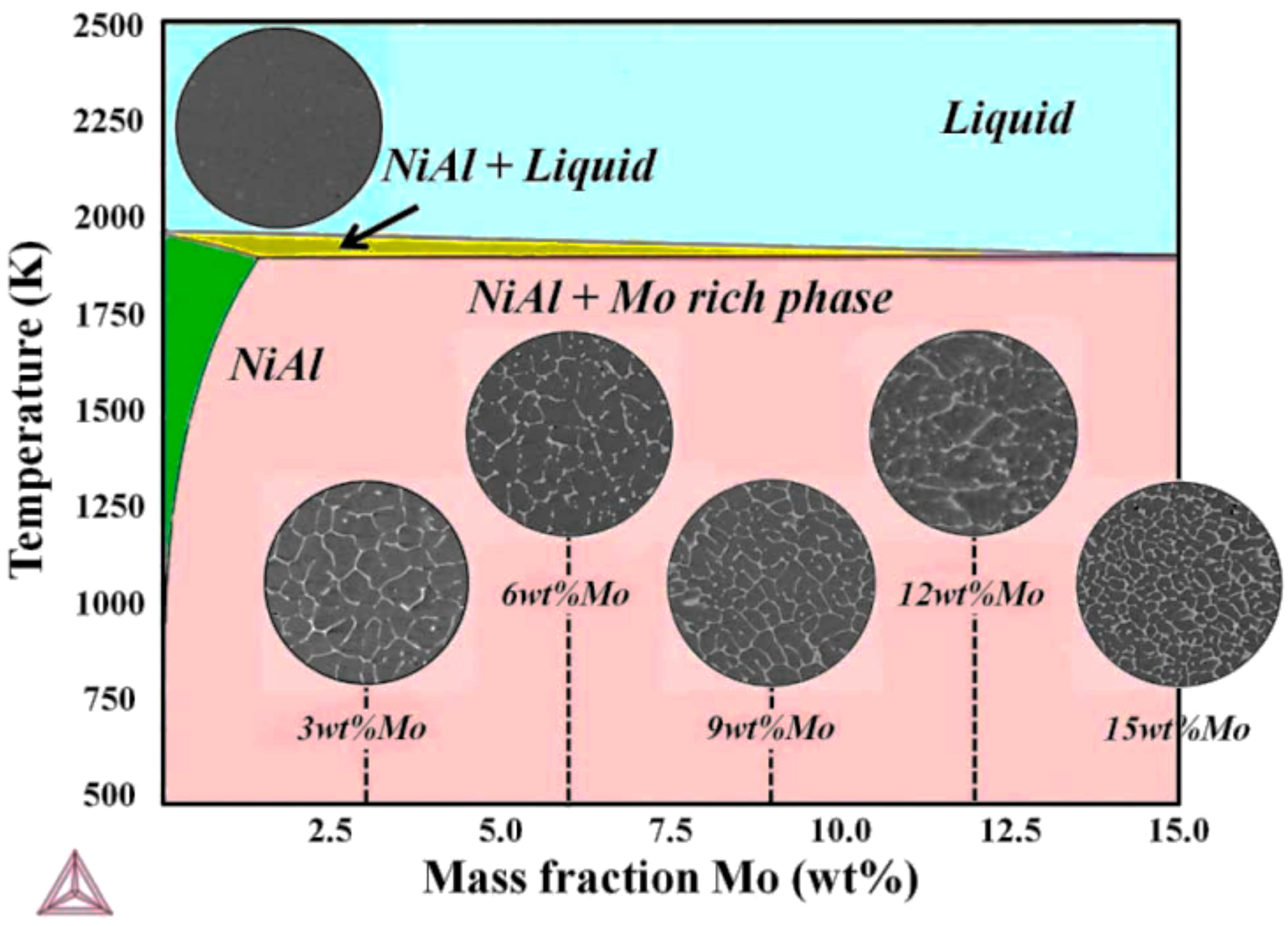
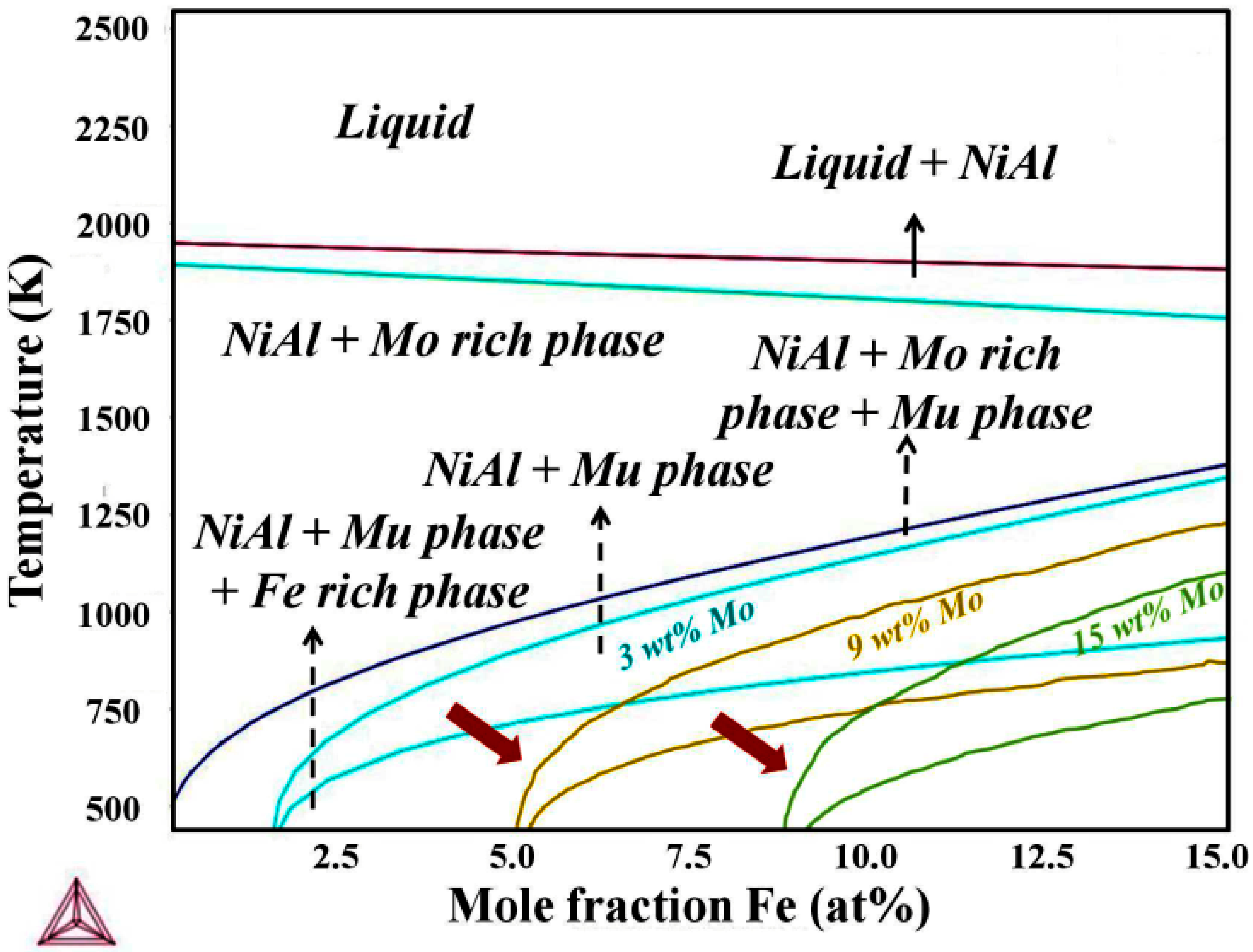
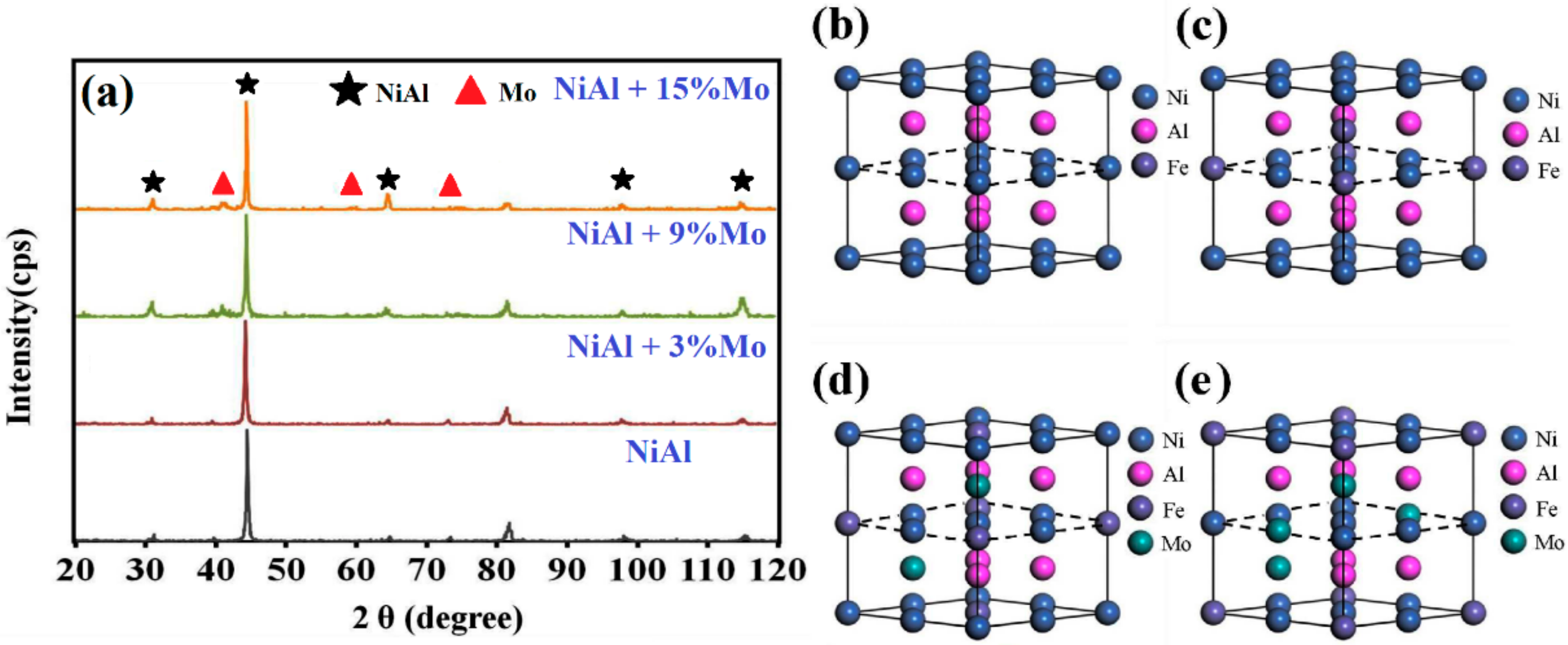
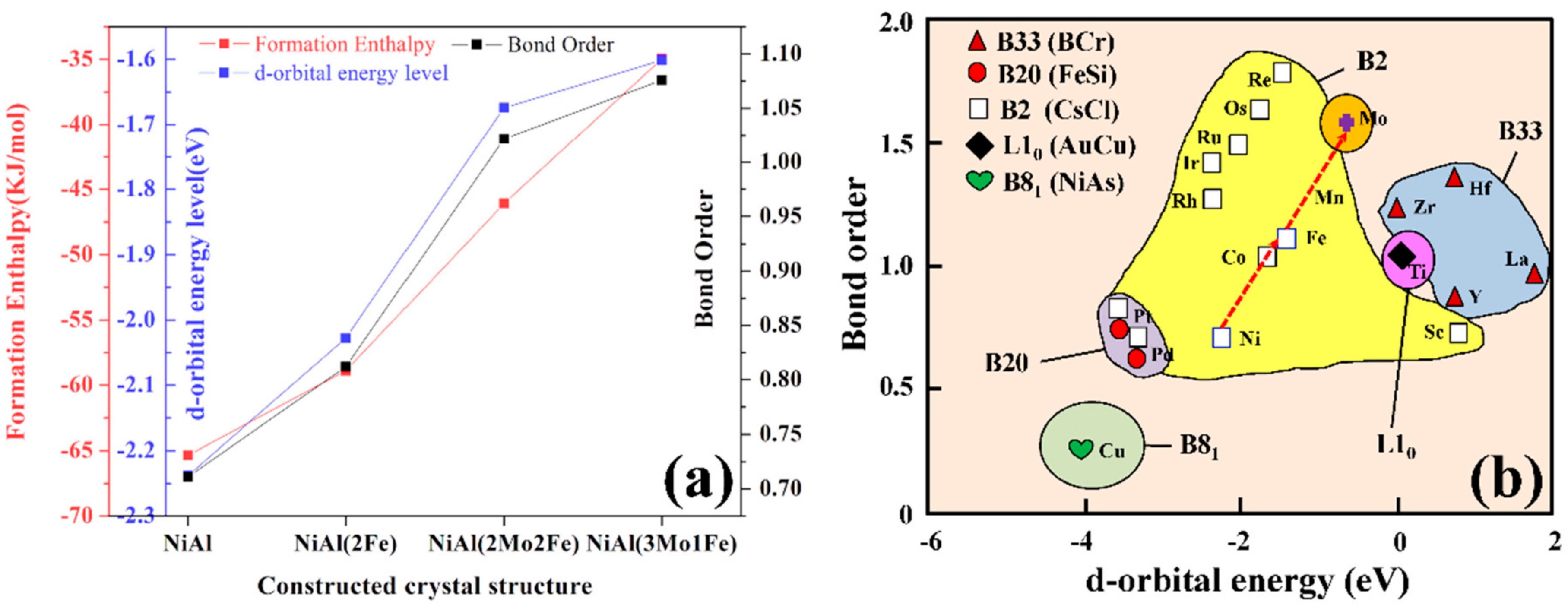
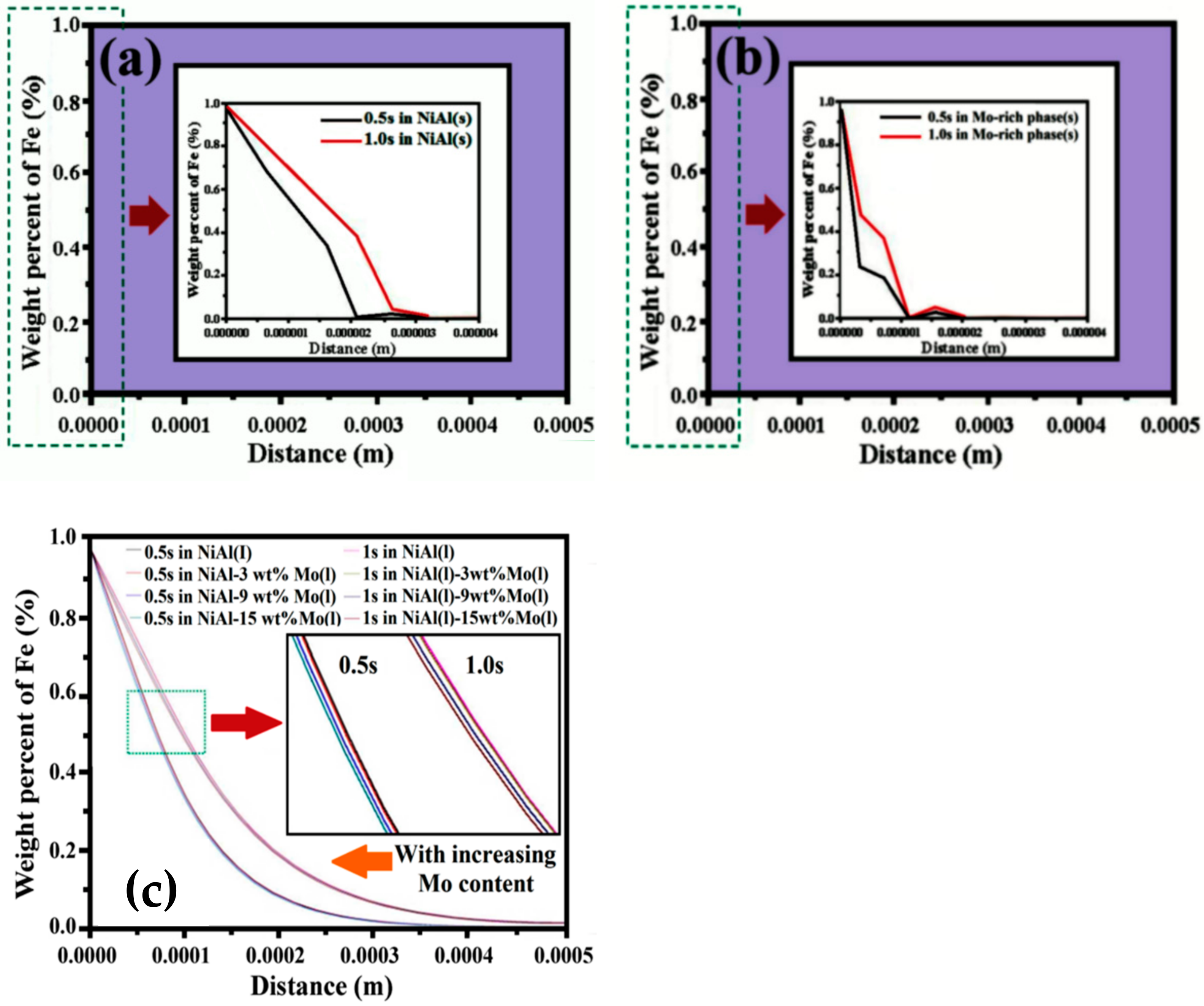
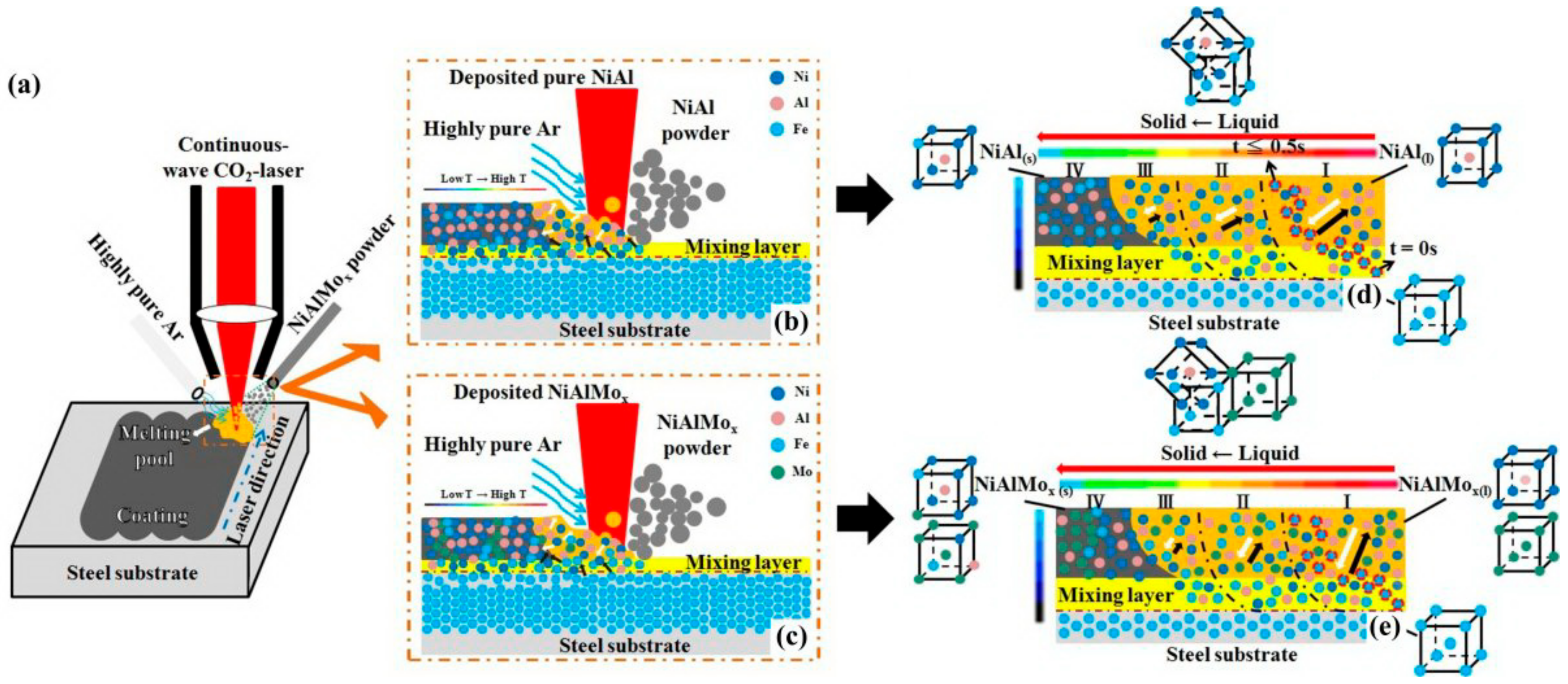
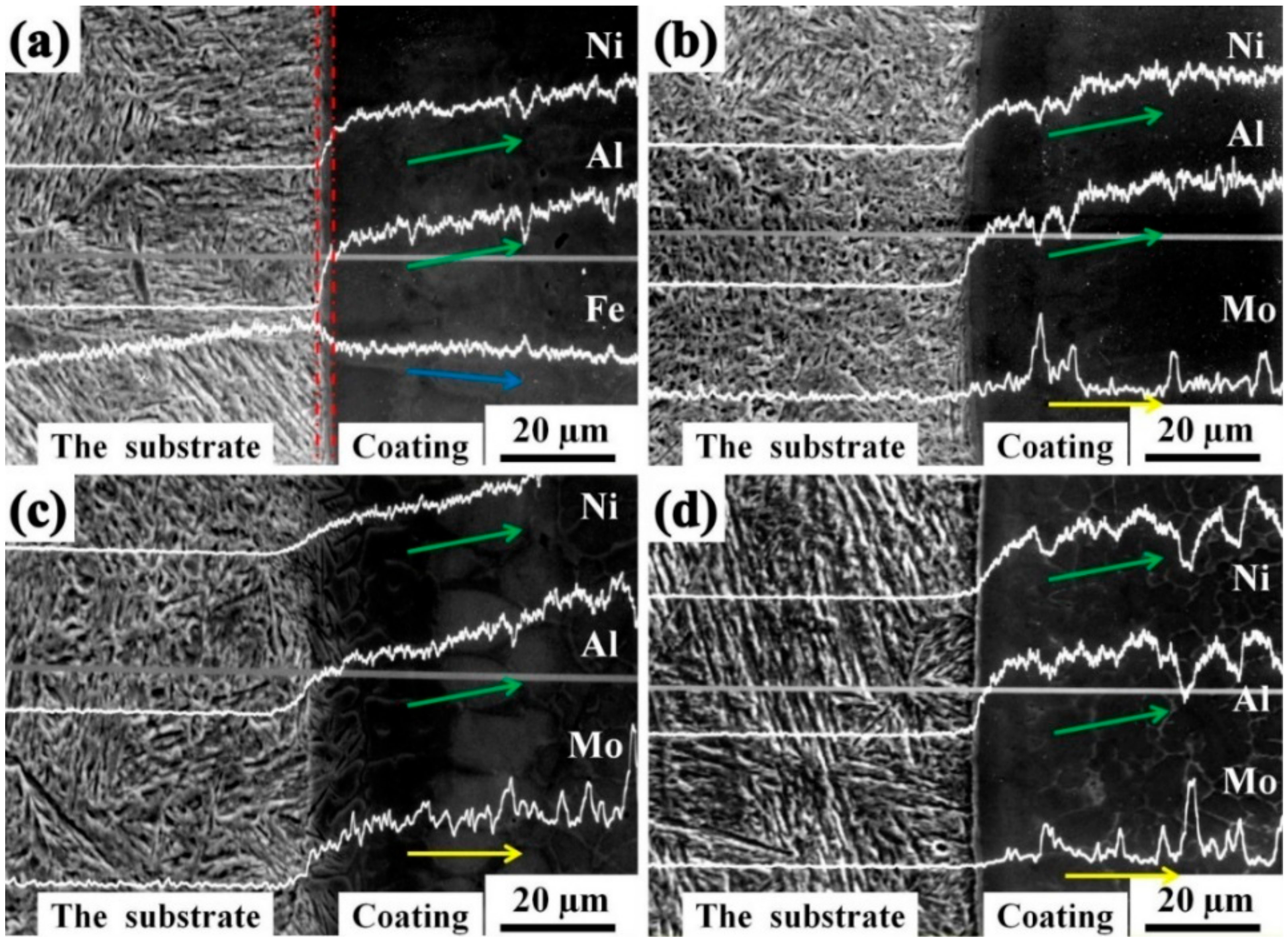
| Supercell | Ni | Al | Fe | Mo | Structure | Formation Enthalpy |
|---|---|---|---|---|---|---|
| NiAl | 8 | 8 | - | - | −65.34 | |
| NiAl (2Fe) | 7 | 7 | 2 | −58.89 | ||
| NiAl (2Mo2Fe) | 6 | 6 | 2 | 2 | −46.08 | |
| NiAl (3Mo1Fe) | 6 | 6 | 1 | 3 | −34.96 | |
| Mo | - | - | - | 16 | −1936.89 |
Publisher’s Note: MDPI stays neutral with regard to jurisdictional claims in published maps and institutional affiliations. |
© 2022 by the author. Licensee MDPI, Basel, Switzerland. This article is an open access article distributed under the terms and conditions of the Creative Commons Attribution (CC BY) license (https://creativecommons.org/licenses/by/4.0/).
Share and Cite
Lin, C.-M. Predicting the Effect of Mo Addition on Metastable Phase Equilibria and Diffusion Path of Fe in NiAl Laser-Clad Coatings Using First-Principle Calculations and CALPHAD Simulations. Processes 2022, 10, 1228. https://doi.org/10.3390/pr10061228
Lin C-M. Predicting the Effect of Mo Addition on Metastable Phase Equilibria and Diffusion Path of Fe in NiAl Laser-Clad Coatings Using First-Principle Calculations and CALPHAD Simulations. Processes. 2022; 10(6):1228. https://doi.org/10.3390/pr10061228
Chicago/Turabian StyleLin, Chun-Ming. 2022. "Predicting the Effect of Mo Addition on Metastable Phase Equilibria and Diffusion Path of Fe in NiAl Laser-Clad Coatings Using First-Principle Calculations and CALPHAD Simulations" Processes 10, no. 6: 1228. https://doi.org/10.3390/pr10061228
APA StyleLin, C.-M. (2022). Predicting the Effect of Mo Addition on Metastable Phase Equilibria and Diffusion Path of Fe in NiAl Laser-Clad Coatings Using First-Principle Calculations and CALPHAD Simulations. Processes, 10(6), 1228. https://doi.org/10.3390/pr10061228





